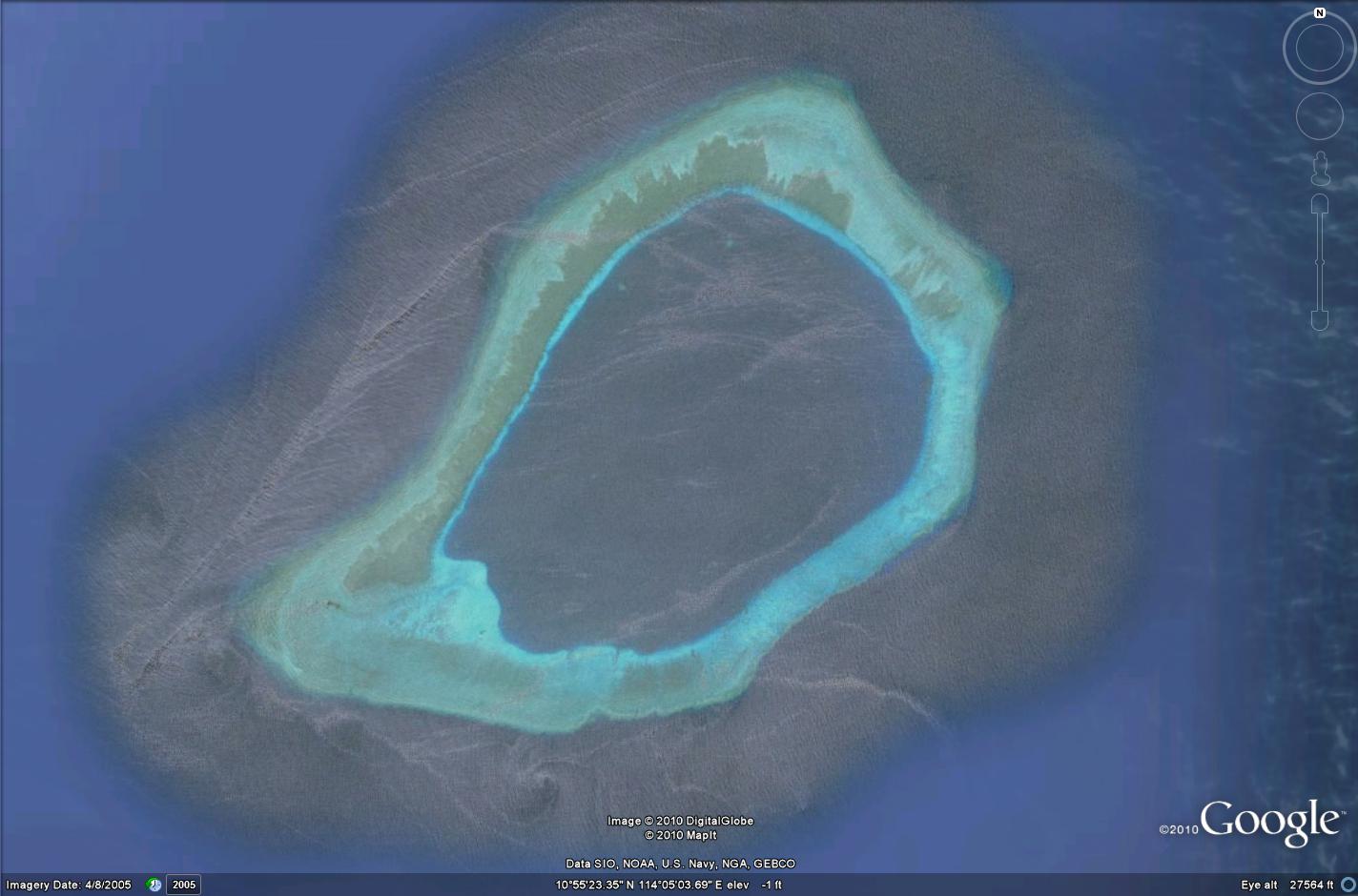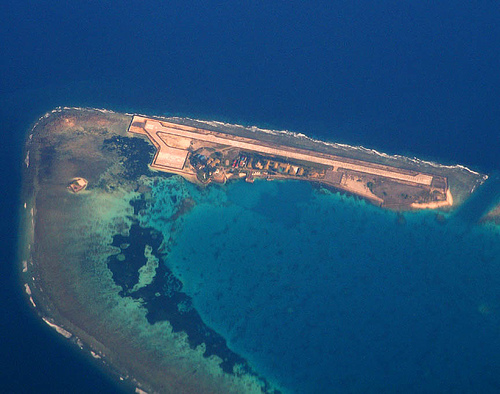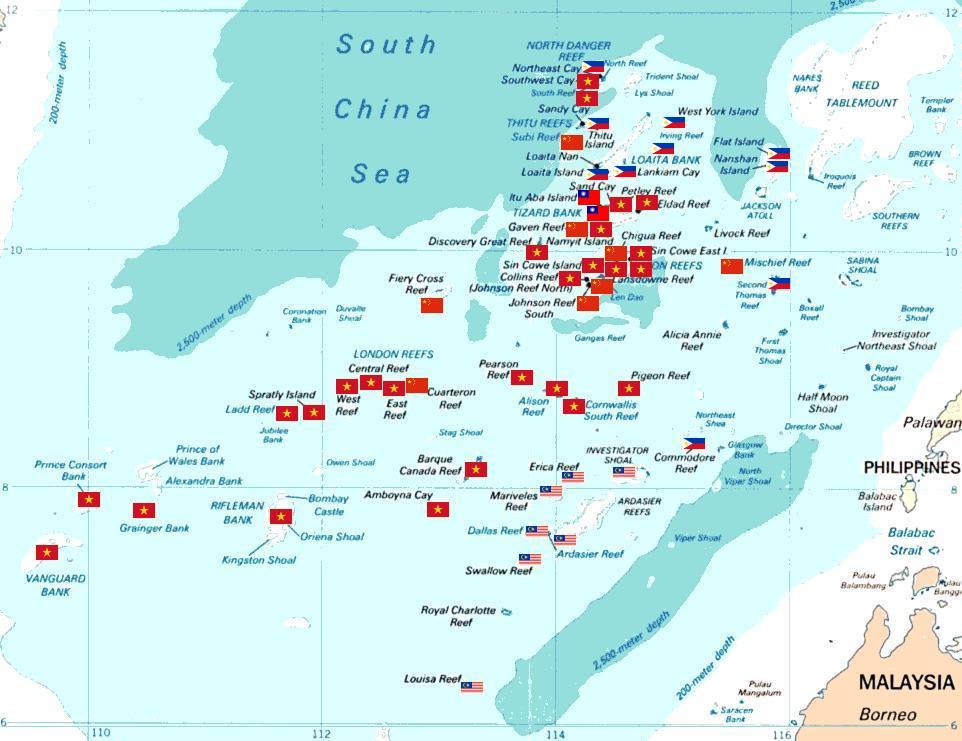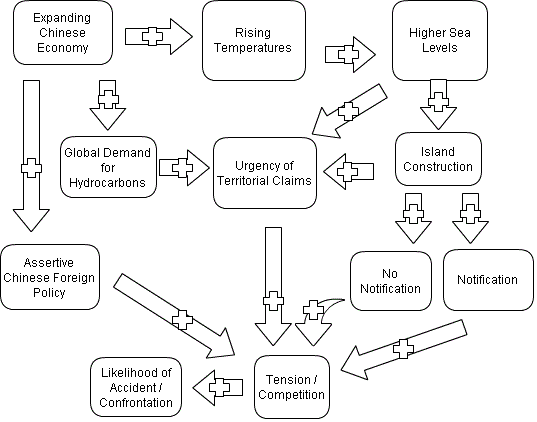
| ICE Case Studies
|
Spratly Islands Strategic Importance and Rising Sea Levels (SPRATLY-SUBMERGE) by Mike Lally |
I.
Case Background |

The Spratly Islands are located in the South China Sea and consist of over 100 small islands and reefs, territorially contested by the governments of the People's Republic of China, the Republic of China (Taiwan), Vietnam, Brunei, the Philippines, and Malaysia. None of the islands lies more than 4m above sea level, with many actually lying below sea level at high tide. The combined area of the islands is approximately 5 sq km. The islands are considered strategically important because of their location in strategic shipping lanes, extensive fisheries, and the large amounts of hydrocarbons estimated to lie under the ocean bed. Approximately 45 of the islands are occupied by military forces of the claimant countries, and none of the islands have indigenous inhabitants. Tension in the region over competing territorial claims has occasionally boiled over in the past into limited military skirmishes, although a recent ASEAN accord has limited open disputes. [1] Rising sea levels and global competition for energy resources have increased tensions, especially in the context of rapidly expanding economies in the Asian region and the increased assertiveness related to territorial claims that has accompanied economic growth in China. The US has attempted to remain relevant in the discussion, because of the presence of energy resources and shipping lanes in the region, as well as requests by regional allies to act as a counter-balance to Chinese aggression. [2] As sea levels rise, many reefs and islands are likely to be submerged, increasing the urgency of territorial claims, requiring construction of new facilities, and increasing the likelihood of confusion and accidents between naval patrols or fishing vessels around newly submerged reefs.
The dispute began in 110 CE when China first asserted its control of the islands during the repression of rebellion in Vietnam, and began using the islands as a stopping over point for trading, fishing, and military ventures. [3] The most recent contemporary occupation of the islands seems to have been France in the early 1930’s, until the islands were taken by Japan in 1938 and used as a submarine resupply base until the end of WWII. From 1946 to 1950, the main island was occupied by forces from the Republic of China, and Japan officially renounced its claim to the islands in 1951. The ROC reoccupied the main island in 1956, and Vietnam began occupying several islands in 1973, with the Philippines following suit in 1978, Malaysia in 1983, and the People’s Republic of China in 1988. None of the claims were accepted diplomatically, and their official status remains undetermined. [4] In 2002 the "Declaration on the Conduct of Parties in the South China Sea" was signed, but holds no legal binding. [1] In 2010, after the Chinese-Japanese confrontation around Senkaku Island the parties again committed themsevles to peaceful resolution of the South China Sea issue. The US weighed in saying it was in its national interests and regional interests to see the issue resolved peacefully and protect vital sea lanes, and suggested it could play a mediating role. This announcement angered China, who alleged the US was performing military operations in its territorial waters, and had no business interfering in what should be a bilateral affair between China and individual claimaint countries, a stance disputed by the other members of ASEAN. [13]
The largest of the islands is Itu Aba, at 0.43 sq. km. There are only six more islands greater than 0.1 sq. km, including West York Island, Spratly Island, Northeast Cay, Southwest Cay, Sandy Cay, and Thitu Island. The highest island is Namyit Island. There are only ten islands that are able to naturally sustain trees, [5] four of the islands have airports, and three have heliports. [1] Of the occupied islands, several can be classified as artificial islets, in that they do not naturally lie above sea level without human construction of structures. This includes Chinese occupations at Subi Reef, Johnson South Reef, and Mischief Reef, Malaysia's occupations at Dallas Reef and Investigator Shoals, and Vietnam's occupations at Vanguard and Prince of Wales Banks. [6] Technically such artificial islands are not allowed to generate territorial claims under the UN Convention on the Law of the Sea. [6]
There have been a number of recent military disputes and diplomatic incidents in the South China Sea. In March 1988 China and Vietnam briefly clashed over the islands, China sank three Vietnamese ships, killed 72, and captured 9. [3] Again, in 1995, the Philippines discovered the construction of concrete support structures on Johnson Reef, and protested this by increasing naval patrols in the region and intercepting Chinese fishermen in the region. In 1999, further construction was discovered and caused another similar incident. [6] In 2002 claimaint countries at an ASEAN meeting signed a "Declaration on the Conduct of Parties in the South China Sea," but it was not legally binding. [1] There have been several seizures of Vietnamese fishermen by the Chinese since then as well. [7] In 2009 there was a confrontation between a US naval patrol vessel performing seismic surveillance, when it claimed it was harassed by a number of Chinese vessels. The US claimed it was travelling in international waters and had rights of navigation and passage, while China suggested that the ship, gathering sonar data, was performing an intelligence operation in territorial waters claimed by China. [8]
As the recent collision between a Chinese fishing vessel and Japanese naval patrols in the Senkaku Islands has shown, minor incidents and accidents have the potential to escalate to national levels and drastically increase tensions and consequences related to territorial disputes. [9] Recent naval exercises by the United States and Vietnam demonstrate the involvement of the US, and its cocern for international navigation and trade rights in the South China Sea and desire to form a strategic partnership with Vietnam. [10] China has also increased naval patrols in the region claiming its necessary to counter illegal fishing in its territorial waters. [11] It has also staged several military exercises it has claimed demonstrate its ability to protect its interests militarily in the region. [12] As sea levels rise, many reefs and islands are likely to be submerged, increasing the urgency of territorial claims, requiring construction of new facilities, and increasing the likelihood of confusion and accidents between naval patrols or fishing vessels around newly submerged reefs.
Figure 1: A map of mischief reef, where China has artificial island structures. (source: Google Earth)

Figure 2: A map of Subi reef, where China has artificial structures (source: Google Earth)

Figure 3: A aerial shot of Malaysia occupied Swallow Reef (source: Flickr Creative Commons, Storm Crypt)

Figure 4: A view of a dock at Vietnam occupied Pearson Reef (source: Wikimedia Commons, Ha Petit)
Figure 5: A picture of artificial structures at Vietnam occupied West London Reef (source: Wikimedia Commons, Ha Petit)
Chinese occupation of the islands began in 110 CE, around the same time as colonization of Vietnam. The islands were used by Chinese sailors as a stay over until roughly 1933 when France took over the islands began changing hands up until today's current status quo. [3]
Figure 6: Map depicting the claimed and occupied islands of the various countries. Claims are identified by the flag of the country, and as such, only claims by China, Vietnam, Taiwan, Malaysia, and the Philippines are shown, as Brunei has no occupied islands.

(Spratly With Flags, Wikimedia Commons, <http://en.wikipedia.org/wiki/File:Spratly_with_flags.jpg>, accessed Nov 29th, 2010)
China claims all the islands as its own, and desires bilateral resolution of disputes. It has also been seen as the most aggressive in building island structures in the past to lay claim to reefs Namely, cement structures that it claims are shelters for fishermen, and then building light houses or military garrisons upon these if they are not disputed as it did in Mischief reef. [6] China has aggressively pursued expanded blue water navy abilities and engaged in intelligence and surveillance in the South China Sea region. [22]
Taiwan's claims are limited, and complicated by the issue of Taiwan's sovereignty or inclusion as part of China. Regardless, its occupation is likely to persist until its other issues with China are resolved.
Vietnam claims both islands on its continental shelf, and all of the islands. It asserts that Chinese claims are based on China's former subjugation of Vietnam, and thus the islands are rightfully part of Vietnam. There have been military clashes between the two in 1988. It is attempting to build a strategic relationship with the US. It has also announced the acquisition of six new submarines at a cost of $2.4 billion, believed to be designed to bolster its deterrence against Chinese agression in the region. [20]
Malaysia claims a limited number of islands and features on its continental shelf. It has also announced the recent decision to purchase two submarines from France at a cost of $1 billion. [20]
The Philippines claim several islands as part of its Palawan province, and has clashed with China over its construction of artificial structures on Mischief reefs. Yet the Philippines recently announced a massive arms purchase from China, suggesting there may be a changing relationship. [21]
Brunei is the only claimant without militarily occupied islands.
The US is concerned with its right to free passage and navigation in the region, as well as the concerns of its regional allies, Vietnam and the Philippines.
Japan receives almost 90% of its oil shipped through the South China Sea, amongst other goods and commodities. [18]
There are a number of Western and Chinese oil firms involved in exploration in the region, and it was Vietnamese contracts to Western oil companies to explore the region that first led to conflict with China in the 1970's over the islands. The actual amount of oil is disputed or unknown, because of limited exploration thus far.

As previosuly stated, the highest island is only 4m above sea level, but most lie more less equivalent with the Maldives Islands (2m) [19] who have already expressed their concerns over the danger of rising sea levels. In addition, the estimated oil reserves in the South China Sea are largely unknown, creating more incentive for exploration to discern their exact value. The islands are also home to numerous species of turtles and birds that use the islands for roosting, and will be threatened by greater human occupation, oil exploration, or disappearance of the islands into the sea.
Low lying islands reefs especially. Vulnerable to extreme weather events as well, given a small storm surge could overwhelm many garrisons and elicit national response or an international incident.

With six different countries laying claim, and two major regional powers concerned, and the regional body ASEAN involved, the conflict is highly internationalized.
Currently, the conflict seems only to be a risk or threat in the future, but as the incident with Japan illustrated, small incidents in the region could escalate very quickly if tensions are perceived as high.
Past: 1988: 72 Vietnamese sailors killed. This conflict was limited to the Spratlys, but should the conflict escalate into a larger regional dispute, the casualties could be much higher.

Figure 7: Causal Diagram:

The above diagram represents the interactions between rising sea levels and the territorial dispute over the Spratly Islands. Climate change is resulting in rising sea levels, that in turn increases the urgency of territorial claims, as many islands lie only barely above sea level and are likely to be submerged in the near future. Especially on islands where military garrisons exist to back up territorial claims, this will require construction of higher structures to resist the rising seas. This requires notification under the cooperation agreement between the territorial claimants, but will likely result in an increase in tension if it is believed the construction coincides with increased military capability. If there is no notification and it is discovered there has been construction, it will likely increase tension even more. Meanwhile, the expanding Chinese economy plays a role (not the only cause of course) in the increasing temperatures from climate change, and also increased global demand for hydrocarbons. This increased global demand for hydrocarbons also increases the urgency of claims, because of the vast amounts of valuable hydrocarbons estimated to lie underneath the sea bed in the region. Also, an expanding Chinese economy has coincided with a more assertive Chinese foreign policy, as the recent tension between Japan and China in the disputed Senkaku islands demonstrates. That a recent cooperation agreement did not resolve any of the substantive issues regarding the Spratlys means the issue has merely been delayed, but as tension rises, the likelihood of an accident or confrontation that leads to military escalation increases over time. The increased tension has also merited the attention of the United States, whose attempts at mediating were immediately rebuffed angrily by China. [13]
The UN’s Law of the Sea clearly states in Article 121 that any territorial feature of a state that is above high tide is under Article 3 entitled to territorial seas “to a limit not exceeding 12 nautical miles.” [14] Many of the islands and reefs already lie under the surface at high tide, and the highest point in the archipelago is 4m. [5] A projected sea level rise somewhere between 19cm-59cm in the next century is thus extremely relevant. [15] If the dispute were ever to theoretically be adjudicated internationally, islands that have sunk beneath the surface or were already under at high tide could become contentious and complicated issues. Would claims be based on elevations before sea level rises? How would artificial structures built to withstand sea level rises be evaluated in this context? Under the law of the sea, the artificial islands and reefs below sea level at hide tide would not qualify. It is also unclear whether
The UN Convention on the Law of the Sea also states in Article 15, that ““Where the coasts of two States are opposite or adjacent to each other, neither of the two States is entitled, failing agreement between them to the contrary, to extend its territorial sea beyond the median line every point of which is equidistant from the nearest points on the baselines from which the breadth of the territorial seas of each of the two States is measured.” [16] However, even if the participants in the conflict were to accept adjudication, it is not clear which coast or territories would be used, contiguous territory, occupied islands, or claimed islands. To make matters more unclear, it goes on to say “The above provision does not apply, however, where it is necessary by reason of historic title or other special circumstances to delimit the territorial seas of the two States in a way which is at variance therewith.” [16] Of course, it is the allowance for special circumstances to which many states have appealed, and suggested a historical title to the islands. [14] It is all these complications in addition to rising sea levels that make the prospect of mutually agreed international adjudication unrealistic. If this is the case, then states will likely expect to occupy the islands on which they currently have military garrisons for the long term, and thus, especially on low lying islands, need to construct more permanent artificial structures to withstand rising sea levels. Such construction however could be construed in a number of ways, including contributing to an altered balance of force or improved military capabilities.
All of the claimaint countries, as well as regional powers, and ASEAN, have concerns over a potential conflict in such an important trade route, and over regional conflict escalation in general.

Spratly
Aegean
Abumusa-369
Abu musa "
Sources:
[1] CIA World Factbook.
[2] Landler, Mark. "Offering to Aid Talks, U.S. Challenges China on Disputed Islands." New York Times. July 23rd, 2010. < http://www.nytimes.com/2010/07/24/world/asia/24diplo.html?_r=1 >
[3] Jian, Sanqiang, “Multinational Oil Companies and the Spratly Dispute,” Journal of Contemporary China. < http://web.ebscohost.com.proxyau.wrlc.org/ehost/detail?vid=1&hid=107&sid=5bcd9c32-0337-4c74-a134-89139af0639b%40sessionmgr112&bdata=JnNpdGU9ZWhvc3QtbGl2ZQ%3d%3d#db=aph&AN=9711101084>
[4] “Sovereignty Issues: Who Owns the Spratlys?” Southeast Asian Affairs. Singapore: 2000. http://proquest.umi.com.proxyau.wrlc.org/pqdweb?index=0&did=972624881&SrchMode=1&sid=1&Fmt=3&VInst=PROD&VType=PQD&RQT=309&VName=PQD&TS=1291202783&clientId=31806
[5] Van Dyke, Jon M. and Valencia, Mark J. "How Valid Are the South China Sea Claims Under the Law of the Sea Convention?" Southeast Asian Affairs. 2000. <http://web.ebscohost.com/ehost/detail?vid=3&hid=12&sid=1fb187a1-882c-4368-bd46-f09da26afe2f%40sessionmgr4&bdata=JnNpdGU9ZWhvc3QtbGl2ZQ%3d%3d#db=mth&AN=3499208>
[6] "Should Some of the Spratly Features Now Be Characterized as "Artificial Islands", and, If So, What Is Their Legal Status?" Southeast Asian Affairs. 2000. <http://proquest.umi.com.proxyau.wrlc.org/pqdweb?did=972541031&sid=1&Fmt=3&clientId=31806&RQT=309&VName=PQD>
[7] Pham, Nga. "China Releases Vietnam Fishermen." BBC News. August 12th, 2009. < http://news.bbc.co.uk/2/hi/asia-pacific/8196575.stm >
[8] England, Vaudine. "Who's Right in South China Sea Spat?" BBC News. Mar 13th, 2009. < http://news.bbc.co.uk/2/hi/asia-pacific/7941425.stm >
[9] "Japan Extends China Boat Captain's Detention." BBC News. September 10th, 2010. < http://www.bbc.co.uk/news/world-asia-pacific-11256788 >
[10] "US and Vietnam Stage Joint Naval Exercises." BBC News. August 10th, 2010. < http://www.bbc.co.uk/news/world-asia-pacific-10925061 >
[11] "China to step up naval patrols." BBC News. March 19th, 2010. < http://news.bbc.co.uk/2/hi/asia-pacific/7952004.stm >
[12] "China Air Force Exercises 'Carry Message.'" BBC News. August 3rd, 2010. < http://www.bbc.co.uk/news/world-asia-pacific-10849934 >
[13] England, Vaudine. "Why Are South China Sea Tensions Rising?" BBC News. September 2nd, 2010. < http://www.bbc.co.uk/news/world-asia-pacific-11152948 >
[14] “Are the Spratly Islets That Are Above Water at High Tide Entitled to Generate 12-Nautical-Mile Territorial Seas?” Southeast Asian Affairs. Singapore: 2000. <http://proquest.umi.com.proxyau.wrlc.org/pqdweb?index=0&did=972624901&SrchMode=1&sid=2&Fmt=3&VInst=PROD&VType=PQD&RQT=309&VName=PQD&TS=1291204523&clientId=31806>
[15] James Painter. “Americas On Alert For Sea Level Rise.” BBC News. April 8th, 2009. < http://news.bbc.co.uk/2/hi/americas/7977263.stm>
[16] United Nations Convention on the Law of the Sea. <http://www.un.org/Depts/los/convention_agreements/texts/unclos/unclos_e.pdf>
[17] "'Code of conduct' for disputed islands." BBC News.
<http://news.bbc.co.uk/2/hi/asia-pacific/2399425.stm>
[18] Wong, Kam C. "Who Owns the Spratly Islands? The Case of China and Vietnam." China Report. 2002. 38: 345. DOI: 10.1177/000944550203800301. <http://chr.sagepub.com/content/38/3/345.citation>
[19] "The Maldives Battle Against Extinction." BBC News. Nov. 9th, 2009. < http://news.bbc.co.uk/2/hi/south_asia/8350629.stm >
[20] Pomfret, John. "Concerned About China's Rise, Southeast Asian Nations Build Up Militaries." Washington Post, Aug. 9th, 2010.
< http://www.washingtonpost.com/wp-dyn/content/article/2010/08/08/AR2010080802631.html >
[21] McGeown, Kate. "China and Philippines to Sign First Military Deal." BBC News. Dec. 7th, 2010. < http://www.bbc.co.uk/news/world-asia-pacific-11933849 >
[22] Rose, Gideon, and Kaplan, Robert D. "China's Expanding Naval Power." Council on Foreign Relations, April 30th, 2010. <http://www.cfr.org/publication/22040/chinas_expanding_naval_power.html >
Image and Graphic Sources:
Figure 1: Google Earth. Accessed Dec. 13th, 2010.
Figure 2: Google Earth. Accessed Dec. 13th, 2010.
Figure 3: Flickr Creative Commons, Storm Crypt, < http://www.flickr.com/photos/storm-crypt/799085675/ > accessed Dec. 13th, 2010.
Figure 4: Wikimedia Commons, Ha Petit, < http://commons.wikimedia.org/wiki/File:%C4%90%E1%BA%A3o_Phan_Vinh.JPG > accessed Dec. 13th, 2010.
Figure 5: Wikimedia Commons, Ha Petit, < http://commons.wikimedia.org/wiki/File:%C4%90%E1%BA%A3o_%C4%90%C3%A1_T%C3%A2y.JPG > accessed Dec. 13th, 2010.
Figure 6: Wikimedia Commons, <http://en.wikipedia.org/wiki/File:Spratly_with_flags.jpg>, accessed Nov 29th, 2010
